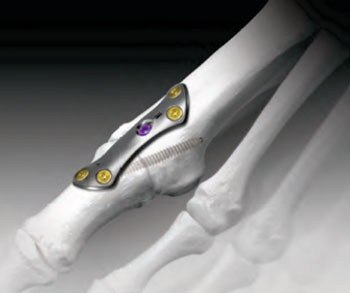New Implant System for Foot and Ankle Procedures
By HospiMedica International staff writers
Posted on 13 Jan 2015
A novel plating system includes ridged plates designed for stabilization and fixation of the joint fusion and reconstruction of small bones in the foot and toes. Posted on 13 Jan 2015
The CrossCHECK NX plating system uses compression slot technology for mechanical compression across the fusion site. The plates are manufactured using a type II anodization process, which enhances the fatigue strength of the system components, thus improving stabilization. In addition, specially designed ridges line the underside of each plate to enhance grip and reduce bone to plate contact, as well as act as a buttress during the compression process. Various sizes and configurations are available for specific surgical needs.

Image: The CrossCHECK MTP compression plate in-situ (Photo courtesy of Solana Surgical).
The compression slot itself is elliptical, with progressive depth; as the non-locking screw is tightened, it seats deeper into the slot, sliding the plate and attached phalanx up to 1.5 mm proximally, while simultaneously closing and compressing the fusion site. The compression slot is featured on a variety of CrossCHECK NX plates, including MTP, Lapidus, and utility plates. The system offers both locking and non-locking T8 Screw options, with the non-locking screws providing a polyaxial alignment of +/- 15°, for a full 30° range of angulation. The CrossCHECK Plating System is a product of Solana Surgical (Memphis, TN, USA).
Bone plating is a method of fracture fixation in which one or more metal plates are applied across the fracture and anchored, usually by screws, into the fragments; the broken bones must first be surgically reset into their proper position. The method does have some drawbacks; after initially placing the plate on the break or fracture the bones are compressed together and held under slight pressure, which helps to speed up the healing process of the bone. Unfortunately, the tension provided by the steel plate is lost after several days and the break or fracture is no longer under compression, slowing the healing process.
Related Links:
Solana Surgical














.jpg)